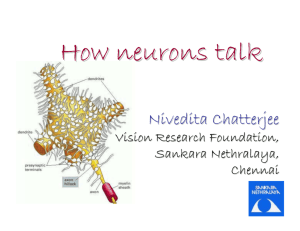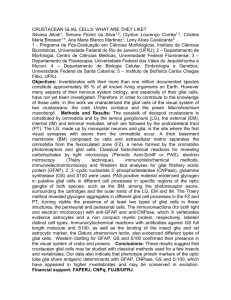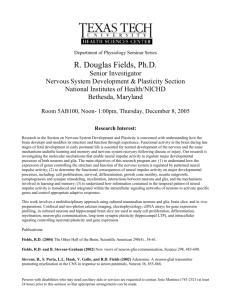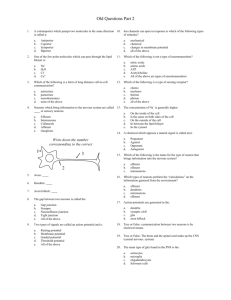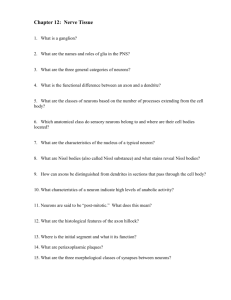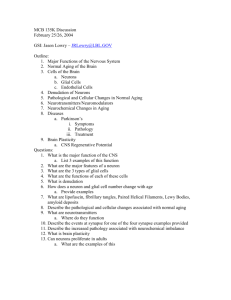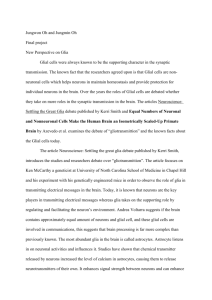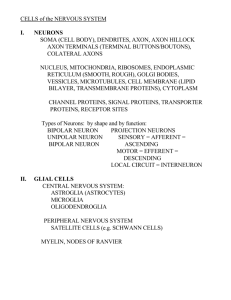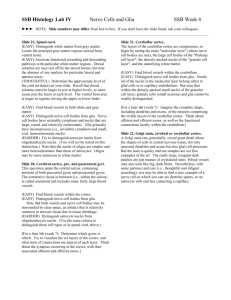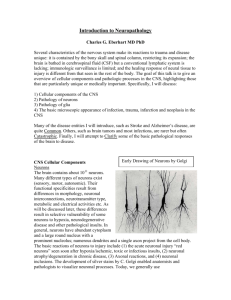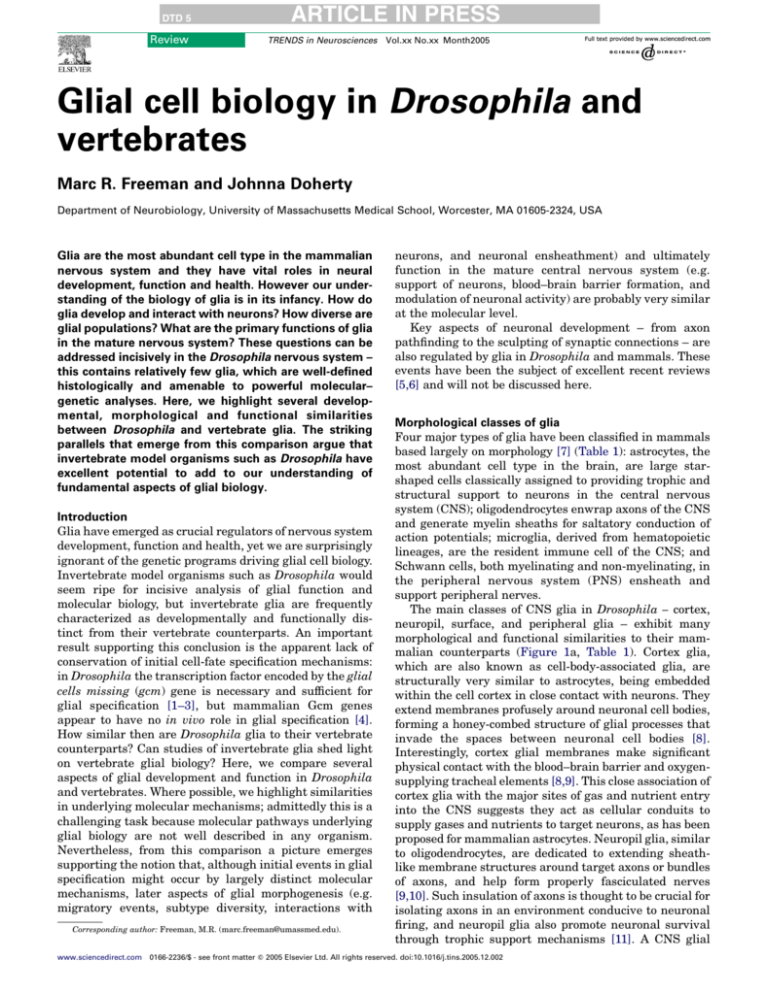
DTD 5
Review
ARTICLE IN PRESS
TRENDS in Neurosciences Vol.xx No.xx Month2005
Glial cell biology in Drosophila and
vertebrates
Marc R. Freeman and Johnna Doherty
Department of Neurobiology, University of Massachusetts Medical School, Worcester, MA 01605-2324, USA
Glia are the most abundant cell type in the mammalian
nervous system and they have vital roles in neural
development, function and health. However our understanding of the biology of glia is in its infancy. How do
glia develop and interact with neurons? How diverse are
glial populations? What are the primary functions of glia
in the mature nervous system? These questions can be
addressed incisively in the Drosophila nervous system –
this contains relatively few glia, which are well-defined
histologically and amenable to powerful molecular–
genetic analyses. Here, we highlight several developmental, morphological and functional similarities
between Drosophila and vertebrate glia. The striking
parallels that emerge from this comparison argue that
invertebrate model organisms such as Drosophila have
excellent potential to add to our understanding of
fundamental aspects of glial biology.
Introduction
Glia have emerged as crucial regulators of nervous system
development, function and health, yet we are surprisingly
ignorant of the genetic programs driving glial cell biology.
Invertebrate model organisms such as Drosophila would
seem ripe for incisive analysis of glial function and
molecular biology, but invertebrate glia are frequently
characterized as developmentally and functionally distinct from their vertebrate counterparts. An important
result supporting this conclusion is the apparent lack of
conservation of initial cell-fate specification mechanisms:
in Drosophila the transcription factor encoded by the glial
cells missing (gcm) gene is necessary and sufficient for
glial specification [1–3], but mammalian Gcm genes
appear to have no in vivo role in glial specification [4].
How similar then are Drosophila glia to their vertebrate
counterparts? Can studies of invertebrate glia shed light
on vertebrate glial biology? Here, we compare several
aspects of glial development and function in Drosophila
and vertebrates. Where possible, we highlight similarities
in underlying molecular mechanisms; admittedly this is a
challenging task because molecular pathways underlying
glial biology are not well described in any organism.
Nevertheless, from this comparison a picture emerges
supporting the notion that, although initial events in glial
specification might occur by largely distinct molecular
mechanisms, later aspects of glial morphogenesis (e.g.
migratory events, subtype diversity, interactions with
Corresponding author: Freeman, M.R. (marc.freeman@umassmed.edu).
neurons, and neuronal ensheathment) and ultimately
function in the mature central nervous system (e.g.
support of neurons, blood–brain barrier formation, and
modulation of neuronal activity) are probably very similar
at the molecular level.
Key aspects of neuronal development – from axon
pathfinding to the sculpting of synaptic connections – are
also regulated by glia in Drosophila and mammals. These
events have been the subject of excellent recent reviews
[5,6] and will not be discussed here.
Morphological classes of glia
Four major types of glia have been classified in mammals
based largely on morphology [7] (Table 1): astrocytes, the
most abundant cell type in the brain, are large starshaped cells classically assigned to providing trophic and
structural support to neurons in the central nervous
system (CNS); oligodendrocytes enwrap axons of the CNS
and generate myelin sheaths for saltatory conduction of
action potentials; microglia, derived from hematopoietic
lineages, are the resident immune cell of the CNS; and
Schwann cells, both myelinating and non-myelinating, in
the peripheral nervous system (PNS) ensheath and
support peripheral nerves.
The main classes of CNS glia in Drosophila – cortex,
neuropil, surface, and peripheral glia – exhibit many
morphological and functional similarities to their mammalian counterparts (Figure 1a, Table 1). Cortex glia,
which are also known as cell-body-associated glia, are
structurally very similar to astrocytes, being embedded
within the cell cortex in close contact with neurons. They
extend membranes profusely around neuronal cell bodies,
forming a honey-combed structure of glial processes that
invade the spaces between neuronal cell bodies [8].
Interestingly, cortex glial membranes make significant
physical contact with the blood–brain barrier and oxygensupplying tracheal elements [8,9]. This close association of
cortex glia with the major sites of gas and nutrient entry
into the CNS suggests they act as cellular conduits to
supply gases and nutrients to target neurons, as has been
proposed for mammalian astrocytes. Neuropil glia, similar
to oligodendrocytes, are dedicated to extending sheathlike membrane structures around target axons or bundles
of axons, and help form properly fasciculated nerves
[9,10]. Such insulation of axons is thought to be crucial for
isolating axons in an environment conducive to neuronal
firing, and neuropil glia also promote neuronal survival
through trophic support mechanisms [11]. A CNS glial
www.sciencedirect.com 0166-2236/$ - see front matter Q 2005 Elsevier Ltd. All rights reserved. doi:10.1016/j.tins.2005.12.002
ARTICLE IN PRESS
DTD 5
2
Review
TRENDS in Neurosciences Vol.xx No.xx Month2005
Table 1. Comparison of vertebrate and Drosophila glial subtypes
Vertebrate glial subtype [7]
Primary functions [7]
Distribution [7]
Astrocytes
Trophic support of neurons,
synapse modulation
Oligodendrocytes
Neuronal ensheathment, trophic
support of neurons, myelination
Immune surveillance,
macrophage function
Ensheathment and support of
peripheral nerves, myelination
Embedded in CNS cell cortex,
ensheathing synapses, CNS
surface
Ensheathing axons in CNS
Microglia
Schwann cells
a
Comparable Drosophila glial
subtypea
Cortex glia (and a subset of
surface glia)
Neuropil glia
Throughout CNS
Cortex, surface and neuropil glia
Ensheathing PNS nerves
Peripheral glia
See text for details regarding morphology and function of Drosophila glial subtypes.
subtype specifically assigned to immune functions, like
mammalian microglia, does not appear to be present in the
Drosophila; rather, all glia seem competent to perform
immune-like functions such as engulfment of neuronal
corpses during development [12,13]. Finally, in the PNS,
CNS-derived peripheral glia ensheath and support peripheral nerves containing motor and sensory axons
[14,15], much like mammalian Schwann cells.
The Drosophila CNS blood–brain barrier consists of a
sheath of flattened, ectoderm-derived surface glia that
isolate neural elements from surrounding tissues and
hemolymph [9,16] (Figure 1b). Extensive glia–glia
pleated septate junctions (pSJs) composed of neurexin
IV, contactin and neuroglian [17] form between surface
glia, and between surface and cortex glia [8]. Recent
work has shown the molecular components of these
pSJs are strikingly similar to those in mammalian
axon–glia paranodal septate junctions on myelinated
axons [18,19]. Embryonic and larval peripheral nerves
are ensheathed by peripheral glia and this barrier,
in contrast to those in the CNS, is bilayered.
The outermost layer of peripheral glia comprises
perineurial cells, which are flattened cells that form
extensive glia–glia pSJs and secrete an acellular neural
lamella that coats the peripheral nerve. Below this
outermost glial sheath lies a second layer of peripheral
glia, referred to as ensheathing glia; these glia also
form a barrier through glia–glia pSJs, and extend
processes profusely among axons to ensheath axonal
components of the peripheral nerve [14,15].
In the mammalian CNS, specialized cerebral endothelial cells provide a first layer of barrier function, lining
brain capillaries and forming continuous tight junctions
along their length (Figure 1b). Surrounding these
endothelial cells, mesoderm-derived pericytes secrete a
basement membrane. Astrocyte endfeet almost completely
surround blood vessels [7]; these endfeet are thought to
represent a major site of uptake of capillary-supplied
nutrients by astrocytes for delivery to target neurons.
Although Drosophila and mammalian blood–brain barriers might appear morphologically distinct, they are
thought to function in highly analogous ways, with each
(a)
(b)
Insect BBB
pSJ
Cortex glia
Neuropil glia
Peripheral nerve
Surface glia
Neuropil
Hemolymph
Mammalian BBB
Astrocyte endfeet
Pericyte
Endothelial cell
Tight junction
Cortex glia
Surface glia
Capillary lumen
TRENDS in Neurosciences
Figure 1. Morphological subclasses of Drosophila glia, and a comparison of blood–brain barriers in insects and mammals. (a) A cross-section of a Drosophila embryonic CNS
hemisegment. Cortex glia are embedded within the neuronal cortex, extending cellular processes to the blood–brain barrier (BBB) and to oxygen-supplying tracheal
elements (not shown). Neuropil glia cover the surface of the neuropil and ensheath axons and dendrites; peripheral glia have a similar role in the PNS (not shown). Surface
glia form a sheath around the CNS that constitutes the BBB. Cortex glia and certain components of the BBB are probably cellular conduits for transfer of nutrients from
trachea or hemolymph to neurons (see text for details). (b) Blood–brain barriers in insects and mammals. Surface glia form a sheath around the Drosophila embryonic CNS.
Extensive glial–glia pleated septate junctions (pSJ) between surface glia, or between surface and cortex glia, form a physical barrier for the passage of small molecules.
Endothelial cells constitute the major ion-selective barrier to small molecules in the mammalian BBB. Astrocytic endfeet ensheath nearly the entire surface area of brain
capillaries and are thought to transfer nutrients from the bloodstream to neurons.
www.sciencedirect.com
DTD 5
Review
ARTICLE IN PRESS
TRENDS in Neurosciences Vol.xx No.xx Month2005
having specific sites capable of blocking the passage of ions
and small molecules [20].
The molecular and morphological diversity of glial
populations is impressive. Extensive enhancer-trap analyses [21] and glial gene expression studies [22] have
identified diverse molecular subclasses of glia in the
relatively simple Drosophila embryonic CNS. In addition,
extraordinary morphological diversity is obvious in
Drosophila glial subtypes: in the adult visual system
alone at least seven distinct morphological subtypes of
neuropil glia have been identified [23]. Less is known
about the molecular diversity of mammalian glia because
fewer glia-specific markers are currently available, but a
similar level of diversity in molecular subtypes does not
seem unlikely. Massive morphological diversity is certainly well documented in mammals, with at least eight
different morphological subclasses of astrocytes having
been described in the human cerebral cortex [7]. It is
reasonable to assume this extreme diversity might
represent an equally varied array of functions for glia.
Exploring the functional significance of this glial diversity
will be exciting, and represents a major challenge for
the future.
Glial migration and nerve assembly
Most glia are not born where they will eventually reside in
the nervous system; instead, they migrate significant
distances from where they are born to highly-specific
target sites. In some cases, glial migration is coordinated
by the same cues that direct axon pathfinding. For
example, a subset of Drosophila glia express roundabout
receptors and use the slit axonal guidance cues to position
themselves properly adjacent to the midline in the
embryonic CNS [24]. Other Drosophila glia express the
receptor Unc-5, which mediates repulsion by netrins, and
they migrate away from netrin sources [13]. Interestingly,
the migration of mammalian optic nerve oligodendrocyte
precursors away from the optic chiasm is also mediated by
repulsive Netrin-1 signaling [25]. Selected Drosophila
glial subtypes, such as surface and cortex glia, can migrate
in the absence of axonal contact [26–28], but the neuropil
glia that eventually ensheath axon tracts clearly prefer
axons as substrates for migration [29,30]. Dynamic
rearrangement of the actin cytoskeleton appears to be a
key feature of Drosophila glial migration [31], and the
novel fear of intimacy gene in is essential to provide a stop
signal for migration [32], but beyond these details
surprisingly little is known about the molecular mechanisms underlying directed glial migrations.
The cellular interactions between neurons and glia
during peripheral nerve development have been carefully
studied in both vertebrates and Drosophila embryos. In
both systems peripheral glia are specified in the CNS and
migrate long distances into the periphery, where they
interact closely with axons to help form and insulate
nerves. During development of the zebrafish PNS, a
subset of axons emerge from the posterior lateral line
placode and pioneer the lateral line (Figure 2). Glia
rapidly associate with these pioneer axons and migrate
along them, but in all cases lag slightly behind axon
growth cones. Glia appear to migrate in a chain with the
www.sciencedirect.com
Wild-type zebrafish
Neuronal
cell bodies
3
Glia
Growing
axons
Misrouted axons
Blocked axon outgrowth
Ablated glia
TRENDS in Neurosciences
Figure 2. Neuron–glia interactions during lateral-line development in zebrafish. In
wild type zebrafish, glia follow axons pioneering the lateral line, never extending
beyond axonal substrates. Leading glia exhibit a ‘pioneering’ phenotype, extending
robust processes in the general direction of migration. Axons eventually form a
tightly fasciculated nerve ensheathed by glia. When axons are misrouted, as in
zebrafish with mutations affecting Sonic hedgehog signaling [29], glia follow
misrouted axons. When axonal outgrowth is blocked by laser ablation of neuronal
cell bodies [29], glia fail to migrate along the lateral line. When glial precursors are
genetically prevented from migrating to the lateral line (in Sox10/cls mutants [29]),
axon outgrowth occurs normally, but major defects in nerve fasciculation are
observed at later stages.
leading glia extending dynamic membrane protrusions,
whereas following glia appear less dynamic and are
apparently led along axons. If axons are misrouted, glia
follow misrouted axons; if axon growth is blocked, glial
migration stalls. Glia are dispensable for proper axon
pathfinding, but they are essential for proper nerve
formation because ablation of lateral line glia leads to
major defects in nerve fasciculation [29].
Extensive work on peripheral nerve formation in
Drosophila embryos has revealed similar dynamic neuron–glia interactions during development. Pioneer motor
axons first exit the Drosophila CNS by projecting through
a small cluster of peripheral glia positioned at the lateral
edge of the CNS. Interestingly, these glia guide motor and
sensory axons across the CNS–PNS border [33] and parse
axons into appropriate fascicles. Similar axon–glia interactions occur in the mammalian CNS–PNS transition
zone [34]. Peripheral glia rapidly associate with pioneer
motoneurons as they extend out of the CNS into the
developing embryonic muscle field [35]. Leading glia
extend actin-rich filopodia, whereas follower glia are far
less dynamic [31], and glial processes never extend beyond
the distal tip of pioneering growth cones [35]. Finally,
DTD 5
4
Review
ARTICLE IN PRESS
TRENDS in Neurosciences Vol.xx No.xx Month2005
perturbation of peripheral glial migration disrupts nerve
fasciculation and projection of peripheral sensory axons
into the CNS [31]; thus peripheral glia are key regulators
of nerve assembly.
These studies indicate that the cellular dynamics of
axon–glia interactions during peripheral nerve development are very similar in Drosophila and vertebrates.
Molecular similarities are now also emerging: Drosophila
peripheral glial require epidermal growth factor receptor
(EGFR) signaling to activate specific glial genes during
axon ensheathment phases, and to drive proper assembly
of sensory axons into the peripheral nerves [36]; similarly,
signaling of ErbB (a mammalian EGFR) is essential in
mammalian Schwann cells to promote survival of sensory
and motor neurons [37,38], and for Schwann cell
migration and myelination in zebrafish peripheral nerves
[39]. These in vivo nerve preparations have also highlighted novel aspects of glial migration, such as the
existence of ‘pioneering’ glial types with growth-cone-like
structures at the leading edge. Such glia are emerging as a
common feature of glia migrating along axons, and highly
dynamic, exploratory glial pioneers have also been
observed during nerve development in the Drosophila
wing [26]. The Drosophila embryonic peripheral nerve
and the zebrafish lateral line now offer an exciting
opportunity to tackle highly interesting questions in
glial development in simple, genetically tractable neural
tissues. Why do these glia have such a strong affinity for
axons? What cues and molecular machinery drive glial
extensions along axonal surfaces? How does a glial cell
know when it has fully ensheathed a neuron?
Trophic support of glia by neurons
Glia become intimately associated with axons during
development, and the ultimate survival of many glial cell
types depends on trophic factors supplied by the neurons
they ensheath. Such a mechanism enables proper balancing of neuronal and glial populations in the developing
nervous system.
Midline glia in the Drosophila embryonic ventral nerve
cord migrate only a short distance along bundles of axons
pioneering commissural axon tracts. These glia separate
anterior and posterior axons bundles, partitioning them
by ensheathment [10]. The ratio of midline glia to
commissural axons is regulated by trophic signals
released by axons: initially midline glia are overproduced,
but commissural neurons produce the transforming
growth factor (TGF)a-like molecule Spitz, for which
midline glia compete; Spitz activates the EGFR–Ras–
mitogen-activated protein kinase (MAPK) pathway in glia
that successfully bind this ligand, thereby inhibiting
midline glial death [40]. In the spinal ventral commissure
of rats, commissural axons are also segregated into
bundles of constant size by midline glia, and axonal and
glial populations remain tightly balanced in numbers
throughout massive growth of the spinal cord [41].
However, the precise role of mammalian midline glia in
spinal commissure formation has not been addressed;
whether neuron–glia trophic interactions similar to those
observed in the Drosophila midline occur during this
developmental event is an interesting and open question.
www.sciencedirect.com
The longitudinal glia are a subclass of Drosophila
neuropil glia that are born at the lateral edge of the
embryonic CNS and migrate medially to the developing
longitudinal axon tracts, where they modulate axon
pathfinding, modulate axon fasciculation and promote
neuron survival [11,42,43]. Initially, longitudinal glia
are also produced in excess, and trophic cues provided
by the neurons they ensheath enable only a subset of
glia to survive. The Drosophila protein Vein, a second
Drosophila EGFR ligand with structural similarity to
mammalian neuregulins, is produced by neurons and
longitudinal glia compete for this ligand. Successful
activation of the EGFR–Ras–MAPK pathway leads to
suppression of glial death [44]. These regulatory events
are highly reminiscent of neuron–glia matching mechanisms in mammals: oligodendrocyte survival depends
on contact with target axons [45]; oligodendrocytes
cultured in the absence of neurons normally die, but
can be significantly rescued by administration of
neuregulins; and inhibiting the ErbB neuregulin
receptor increases oligodendrocyte apoptosis [46].
Thus, EGF–ErbB signaling appears to be a key
conserved mechanism for neuronal trophic support of
ensheathing glial populations in diverse organisms.
Neuronal ensheathment
Glia must ramify their membranes into tortuous morphologies to acquire the aforementioned diverse cellular
phenotypes. Glial sheaths have many functions in the
nervous system: parsing axons into the appropriate
fascicles, compartmentalizing regions of the CNS, isolating axons to enable for firing and, in the case of
myelination, dramatically increasing neuronal conduction
velocity. In the simplest form of ensheathment found in
mammals, bundles of axons are wrapped by glia as part of
a nerve fascicle, with axons laying in direct contact with
one another. Such arrangements are common during
development, for example with pro-myelin-phase
Schwann cells. Glia can also be found wrapping bundles
of axons, with each axon being individually isolated by a
thin glial sheath [7]. Most impressively, myelin sheaths
generated by oligodendrocytes and Schwann cells
ensheath single axons with multi-layered specializations
that enable high-speed saltatory conduction along lengthy
nerves [47].
The relationships between glial sheaths and axons are
very similar in insects. In Drosophila peripheral nerves
(Figure 3a), some axons are ensheathed as part of a nerve
fascicle and directly contact adjacent neurons, whereas
others are ensheathed individually by glial membranes
[15]. Invertebrate glia do not generate myelin sheaths,
and the Drosophila genome lacks orthologs of most myelin
genes (Marc R. Freeman, unpublished). However, Drosophila glia appear capable of forming multi-layered
membrane sheaths around neurons that are morphologically similar to the myelin sheaths of mammals
(Figure 3b), and glial hyper-wrapping of axons has been
observed in at least one Drosophila mutant, swiss cheese
[48]. Multi-layered glial sheaths have also been described
in larger insects such as honeybees, where sheaths can
exhibit up to eight glial wraps around axons, and larger
DTD 5
Review
ARTICLE IN PRESS
TRENDS in Neurosciences Vol.xx No.xx Month2005
5
sheaths in vivo [50]. In addition, several transcription
factors such as Sox-10 [51,52], Brn-2, Oct-6 [53], Krox-20
[54] and NF-kB [55] are essential for myelination;
however, target genes driving the myelination process
have not been identified. In Drosophila, several ensheathment genes have been identified, including wrapper [56],
loco [57] and gliotactin [14]. However, only gliotactin has
been investigated in mice: the mammalian candidate
homolog of gliotactin, which is encoded by neuroligin3, is
indeed expressed at high levels in subtypes of mammalian
brain glia [58] but functional insights into its role in
ensheathment are lacking.
Analysis of an additional Drosophila ensheathment
mutant, fray, is yielding exciting insights into how
ensheathing glia regulate peripheral nerve ionic homeostasis. fray mutants assemble largely normal peripheral
nerves during embryonic development but these nerves
eventually exhibit severe swelling and defasciculation
[15]. fray encodes a kinase very similar to mammalian
STE20/SPS1-related proline/alanine-rich kinase (SPAK).
Interestingly, SPAK has recently been shown to directly
phosphorylate the mammalian NaC–KC–ClK cotransporter NKCC1, and thereby activate solute transport by this
molecule. SPAK can also suppress activity of the mammalian KC–ClK cotransporter KCC2 [59]. These observations
suggest that Fray and SPAK regulate ionic homeostasis
in vivo by directly modulating specific solute transporters
(e.g. fly NKCC1) through phosphorylation. In the absence
of Fray activity in peripheral glia, peripheral nerve ionic
balance is probably compromised and this could underlie
the severe nerve swelling observed in fray mutants.
Figure 3. Neuronal ensheathment in Drosophila. (a) A Drosophila larval peripheral
nerve. Some axons are ensheathed individually by glial membranes (arrows); other
axons are wrapped not individually but as part of a bundle of axons (asterisk).
Reproduced, with permission, from [15]. (b) Glia in the Drosophila thoracic
ganglion can form multi-layered sheaths (arrow) around neurons that are very
similar in morphology to glial sheaths found on myelinated axons. Electron
micrograph courtesy of Robert Wyman.
axons appear to have a greater probability of being
wrapped multiple times [49]. The cellular and molecular
machinery essential to drive multi-layered glial wrapping
of neurons is therefore present in Drosophila and other
insects, but how these profuse membrane specializations
form has not been explored.
The molecular mechanisms coordinating neuronal
ensheathment are poorly understood, but the striking
morphological similarities between glial sheaths suggest
that similar molecular mechanisms might effect insulation of neurons in insects and mammals. In mammals,
neuregulin 1 (type III) is present on axons during
myelination, where it regulates the thickness of myelin
www.sciencedirect.com
Glial functions in the mature nervous system
What do glia do in the mature nervous system? Undoubtedly we are only scratching the surface of their many
functions, but so far two clear roles for glia have been
established in the mature CNS. First, glia are responsible
for recycling of the neurotransmitter glutamate at
synapses, and second, glia provide high-energy metabolic
substrates to neurons to sustain neuronal activity. In
contrast to most other aspects of glial function, these
events have been studied in great detail at the cellular,
molecular and biochemical levels in insects and mammals
and they appear to be very similar in these organisms.
Mammalian astrocytes are closely associated with
synapses and have a key role in the reuptake of
presynaptically released neurotransmitters such as glutamate from the synaptic cleft; such rapid clearance is
essential to terminate the excitatory response and to
enable subsequent firing events [60]. Mammalian glia
accomplish the task of glutamate clearance by expressing
the high-affinity excitatory amino acid transporters
(EAATs) GLAST and GLT-1, which transport extracellular
glutamate into glial cells [61]. Once taken up by glia,
glutamate is converted to glutamine by glutamine
synthetase [62]; glutamine is subsequently transported
back to neurons for re-conversion into glutamate for reuse
in neurotransmission (Figure 4). Similarly, glia in the
retina of honeybees have been shown to take up
extracellular glutamate [63], and Drosophila glia express
high levels of EAAT1 and EAAT2 [13,64], in addition to
ARTICLE IN PRESS
DTD 5
Review
6
TRENDS in Neurosciences Vol.xx No.xx Month2005
Glial cell
Presynaptic
neuron
Lactate
Lactate
(energy)
Glycolysis
Gln
Gln
+++
Glu
EAAT
Glu
Glu
Gs
ADP
Glu
Na+
K+
ATP
Na+/K+
ATPase
TRENDS in Neurosciences
Figure 4. Neuron–glia interactions in glutamate recycling and glucose utilization.
Presynaptically released extracellular glutamate (Glu) is taken up by glia through
high-affinity excitatory amino acid transporters (EAAT), converted to glutamine
(Gln) by glutamine synthetase (Gs), and transported back to neurons for reuse.
Glutamate entry entails the cotransport of NaC into glia. Excess NaC is removed by
the NaC/KC-ATPase through ATP hydrolysis. Low ATP levels stimulate glial
glycolysis and subsequent release of lactate as an energy source for neurons.
glutamine synthetase2 [13]. Thus, insect and mammalian
glia probably recycle glutamate to neurons through
similar biochemical mechanisms.
Maintaining normal levels of extracellular glutamate is
important because an excess can be excitotoxic for
neurons. EAATs have a crucial role in regulating
extracellular glutamate levels. For example, loss or
knock-down of GLAST or GLT-1 in mice results in
increased extracellular glutamate levels, neurodegeneration that shows hallmarks of excitotoxicity, and paralysis
[65]. In Drosophila, loss of EAAT1 similarly triggers
oxidative stress in the adult brain, behavioral abnormalities, and widespread neuronal degeneration [66]. Behavioral defects in these flies are significantly rescued by
application of the anti-excitotoxic agent riluzole, which is
commonly used to treat amyotrophic lateral sclerosis
(ALS) patients [67]. Thus, careful modulation of extracellular glutamate levels by glia through EAATs in both
Drosophila and mammals is crucial to avoid neuronal
excitotoxicity and to maintain functional integrity of the
nervous system.
Mammalian astrocytes are nicely positioned – with
glucose-transporter-expressing endfeet [68] projecting to,
and surrounding, brain capillaries [69] – to act as energy
conduits by taking up glucose and shuttling metabolites to
neurons. Interestingly, the neurotransmitter glutamate
appears to incite glia to provide metabolic intermediates to
neurons (Figure 4), thereby coupling neuronal activity
with glial contributions of high-energy metabolites to
neurons. Glutamate uptake by mammalian glia is
associated with the cotransport of Na C. Increased
intracellular NaC concentrations stimulate the NaC/KCATPase to remove intracellular NaC. Subsequent
www.sciencedirect.com
decreases in levels of intracellular ATP (which is
hydrolyzed to drive NaC export) activates glycolysis [70–
72]. Lactate, an end product of glycolysis, is then released
by glia and probably taken up by neurons, where it can be
used as an energy source to drive neuronal activity
[71,73]. Recent work with GLAST-knockout and GLT-1knockout mice has identified these EAATs as key players
in the metabolic coupling of neurons and glia. Enhanced
glucose utilization in glia stimulated by synaptic activity
is decreased in the absence of these EAATs, and GLAST
appears to be essential for glutamate-induced increases in
intracellular NaC levels and subsequent lactate production by astrocytes [71].
Metabolic coupling between neurons and glia has
also been studied extensively in the honeybee drone
retina, where detailed biochemical analyses are possible
[74]. Glia are the cell type in the retina that take up
and metabolize the most extracellular glucose [75], and
glia accumulate massive stores of glucose in the form of
glycogen [76]. Glycogen breakdown is rapidly induced
by neuronal activity [77]; thus, insect glia can also
respond metabolically to neuronal activity. NHC
4 (which
is released from activated photoreceptor neurons) or
application of glutamate alone to retinae stimulates
glycolysis in glia [63]. Finally, when stimulated by
neuronal activity, retinal glia release large amounts of
the metabolic intermediate alanine, which is then taken
up by photoreceptors and probably used to fuel
neuronal activity [76]. Neurons and glia are thus
tightly coupled metabolically in both insects and
mammals, with glia clearing extracellular glutamate,
recycling it to neurons, and dynamically supplementing
neuronal energy demands.
The nature and amount of additional ions, metabolic
substrates or neurotransmitters exchanged between
neurons and glia is poorly defined, but the list is likely
to be extensive. For example, mammalian glia can take up
noradrenaline and dopamine [78], in addition to aspartate
and GABA [79], and astrocytes seem to provide cholesterol
to mature neurons [80]. Insect glia also metabolize
additional neurotransmitters such as GABA [81] and
histamine [82]. Both Drosophila and mammalian glia
express an array of ion channels with diverse predicted
substrates [13,83]. Roles for these transporters probably
include maintaining an appropriate balance of extracellular ions or small molecules to facilitate neuronal function.
Do glia participate meaningfully in neural physiology,
CNS information processing, or higher brain functions
such as learning and memory? Glia-secreted factors
clearly promote CNS synaptogenesis in vivo [84]. This
observation raises the exciting possibility that not only
synapse development but also synaptic plasticity could be
influenced by glia. Astrocytes can also respond to neuronal
activity or glutamate release with transient increases in
cytosolic Ca2C concentrations; they can propagate these
signals via Ca2C waves or oscillations through gap
junctions, and increased glial Ca2C levels can modulate
local neuronal activity [85,86]. Thus, glia can provide
modulatory feedback to neurons, but are these Ca2C
waves and this feedback important in vivo for the function
of neural circuits? Studies in Drosophila provide
DTD 5
Review
ARTICLE IN PRESS
TRENDS in Neurosciences Vol.xx No.xx Month2005
additional hints at potential roles for glia in behavior and
neural physiology. For example, glial-expressed cathepsin
is involved in the formation of olfactory-associative longterm memory, and long-term memory formation somehow
reciprocally regulates cathepsin levels [87]. Are glia
communicating with neurons during memory formation?
Drosophila glia also secrete factors such as axotactin,
which can regulate the electrophysiological properties of
the ensheathed neurons [88], but the breadth of such glial
regulation of neural activity in the nervous system and its
functional significance have not been explored.
7
Acknowledgements
We thank William Leiserson (Yale University) and Robert Wyman (Yale
University) for generously providing the electron micrographs shown in
Figures 3(a) and 3(b), respectively. We thank Jennifer M. MacDonald and
Mary Logan for critical reading of the manuscript, and anonymous
reviewers for excellent suggestions. We apologize to those authors whose
work we were unable to cite owing to space limitations. Our research is
supported by a Smith Family New Investigator Award (to M.R.F.) from
the Smith Family Foundation, Chestnut Hill, MA USA, and M.R.F. is an
Alfred P. Sloan Research Fellow.
References
Closing remarks
Interest in glial cell biology has increased dramatically in
the past decade with the realization that glia not only
support neurons but also regulate important aspects of
nervous system development and function. Recent surprises regarding glial functions include roles for glia as
neural stem cells [89], glial regulation of the developmental timing of sensory organ formation [90], and glial
modulation of synapse formation and efficacy [91]. A
decade ago the suggestion that glia could perform such
tasks would be met with extreme skepticism, but our
understanding of this dynamic cell type is evolving
rapidly. Few studies, if any, have yet addressed directly
the in vivo requirements for glia in CNS information
processing and behavioral output. Major future goals
include defining how glia influence synaptic function and
plasticity in vivo, and determining whether glia have a
meaningful role in information processing by neural
circuits. Our understanding of this cell type is finally
creeping above woeful ignorance and insights into glial
development and function are likely to advance profoundly in coming years.
From the moment glia are born they are intimately
associated with neurons, and these two cell types are
highly interdependent for normal development and
function. Exploration of glial cell biology and neuron–
glia interactions therefore seems most appropriate in the
intact nervous system. Drosophila offers an excellent
opportunity for in vivo studies of glia in a genetically
tractable organism. Drosophila glial lineages have been
defined at single-cell resolution in the embryonic CNS,
and an impressive array of glial markers and genetic tools
already enable the manipulation of specific glial subtypes.
Moreover, the Drosophila nervous system can be explored
at many levels, from the morphogenesis of individual glial
cell types to the behavioral outputs modulated by specific
populations of glia. Thus, a wide range of exciting
questions regarding how glia develop and function can
be explored in Drosophila and, importantly, the underlying molecular pathways can be rapidly identified by
powerful forward-genetic screens. The current literature,
as outlined in this review, suggests that Drosophila glia
are indeed very similar to their mammalian counterparts
by developmental, morphological, functional and probably
molecular criteria. Future work exploiting the tools
available in Drosophila to understand glial biology should
therefore contribute in important ways to our understanding of this enigmatic cell type.
www.sciencedirect.com
1 Jones, B.W. et al. (1995) glial cells missing: a genetic switch that
controls glial versus neuronal fate. Cell 82, 1013–1023
2 Hosoya, T. et al. (1995) glial cells missing: a binary switch between
neuronal and glial determination in Drosophila. Cell 82, 1025–1036
3 Vincent, S. et al. (1996) Glide directs glial fate commitment and cell
fate switch between neurones and glia. Development 122, 131–139
4 Kim, J. et al. (1998) Isolation and characterization of mammalian
homologs of the Drosophila gene glial cells missing. Proc. Natl. Acad.
Sci. U. S. A. 95, 12364–12369
5 Chotard, C. and Salecker, I. (2004) Neurons and glia: team players in
axon guidance. Trends Neurosci. 27, 655–661
6 Edenfeld, G. et al. (2005) Neuron–glia interaction in the insect
nervous system. Curr. Opin. Neurobiol. 15, 34–39
7 Kettenmann, H. and Ransom, B.R. (2005) Neuroglia, Oxford
University Press
8 Pereanu, W. et al. (2005) Morphogenesis and proliferation of the larval
brain glia in Drosophila. Dev. Biol. 283, 191–203
9 Ito, K. et al. (1995) Distribution, classification and development of
Drosophila glial cells in the late embryonic and early larval ventral
nerve cord. Roux’s Arch. Develop. Biol. 209, 289–307
10 Klambt, C. et al. (1991) The midline of the Drosophila central nervous
system: a model for the genetic analysis of cell fate, cell migration, and
growth cone guidance. Cell 64, 801–815
11 Booth, G.E. et al. (2000) Glia maintain follower neuron survival during
Drosophila CNS development. Development 127, 237–244
12 Sonnenfeld, M.J. and Jacobs, J.R. (1995) Macrophages and glia
participate in the removal of apoptotic neurons from the Drosophila
embryonic nervous system. J. Comp. Neurol. 359, 644–652
13 Freeman, M.R. et al. (2003) Unwrapping glial biology: Gcm target
genes regulating glial development, diversification, and function.
Neuron 38, 567–580
14 Auld, V.J. et al. (1995) Gliotactin, a novel transmembrane protein on
peripheral glia, is required to form the blood-nerve barrier in
Drosophila. Cell 81, 757–767
15 Leiserson, W.M. et al. (2000) Fray, a Drosophila serine/threonine
kinase homologous to mammalian PASK, is required for axonal
ensheathment. Neuron 28, 793–806
16 Edwards, J.S. et al. (1993) The differentiation between neuroglia and
connective tissue sheath in insect ganglia revisited: the neural lamella
and perineurial sheath cells are absent in a mesodermless mutant of
Drosophila. J. Comp. Neurol. 333, 301–308
17 Bhat, M.A. et al. (2001) Axon–glia interactions and the domain
organization of myelinated axons requires neurexin IV/Caspr/Paranodin. Neuron 30, 369–383
18 Bhat, M.A. (2003) Molecular organization of axo–glial junctions. Curr.
Opin. Neurobiol. 13, 552–559
19 Bellen, H.J. et al. (1998) Neurexin IV, caspr and paranodin – novel
members of the neurexin family: encounters of axons and glia. Trends
Neurosci. 21, 444–449
20 Juang, J.L. and Carlson, S.D. (1994) Analog of vertebrate anionic sites
in blood–brain interface of larval Drosophila. Cell Tissue Res. 277,
87–95
21 Klambt, C. and Goodman, C.S. (1991) The diversity and pattern of glia
during axon pathway formation in the Drosophila embryo. Glia 4,
205–213
22 Freeman, M.R. et al. (2003) Unwrapping glial biology. Gcm target
genes regulating glial development, diversification, and function.
Neuron 38, 567–580
DTD 5
8
Review
ARTICLE IN PRESS
TRENDS in Neurosciences Vol.xx No.xx Month2005
23 Kretzschmar, D. and Pflugfelder, G.O. (2002) Glia in development,
function, and neurodegeneration of the adult insect brain. Brain Res.
Bull. 57, 121–131
24 Kinrade, E.F. et al. (2001) Roundabout signalling, cell contact and
trophic support confine longitudinal glia and axons in the Drosophila
CNS. Development 128, 207–216
25 Sugimoto, Y. et al. (2001) Guidance of glial precursor cell migration by
secreted cues in the developing optic nerve. Development 128,
3321–3330
26 Aigouy, B. et al. (2004) Time-lapse and cell ablation reveal the role of
cell interactions in fly glia migration and proliferation. Development
131, 5127–5138
27 Rangarajan, R. et al. (1999) Migration and function of glia in the
developing Drosophila eye. Development 126, 3285–3292
28 Freeman, M.R. and Doe, C.Q. (2001) Asymmetric Prospero localization is required to generate mixed neuronal/glial lineages in the
Drosophila CNS. Development 128, 4103–4112
29 Gilmour, D.T. et al. (2002) Migration and function of a glial subtype in
the vertebrate peripheral nervous system. Neuron 34, 577–588
30 Dearborn, R., Jr. and Kunes, S. (2004) An axon scaffold induced by
retinal axons directs glia to destinations in the Drosophila optic lobe.
Development 131, 2291–2303
31 Sepp, K.J. and Auld, V.J. (2003) RhoA and Rac1 GTPases mediate the
dynamic rearrangement of actin in peripheral glia. Development 130,
1825–1835
32 Pielage, J. et al. (2004) The Drosophila transmembrane protein Fearof-intimacy controls glial cell migration. Dev. Biol. 275, 245–257
33 Sepp, K.J. et al. (2001) Peripheral glia direct axon guidance across the
CNS/PNS transition zone. Dev. Biol. 238, 47–63
34 Fraher, J.P. (1997) Axon–glial relationships in early CNS–PNS
transitional zone development: an ultrastructural study.
J. Neurocytol. 26, 41–52
35 Sepp, K.J. et al. (2000) Developmental dynamics of peripheral glia in
Drosophila melanogaster. Glia 30, 122–133
36 Sepp, K.J. and Auld, V.J. (2003) Reciprocal interactions between
neurons and glia are required for Drosophila peripheral nervous
system development. J. Neurosci. 23, 8221–8230
37 Riethmacher, D. et al. (1997) Severe neuropathies in mice with
targeted mutations in the ErbB3 receptor. Nature 389, 725–730
38 Woldeyesus, M.T. et al. (1999) Peripheral nervous system defects in
erbB2 mutants following genetic rescue of heart development. Genes
Dev. 13, 2538–2548
39 Lyons, D.A. et al. (2005) erbb3 and erbb2 are essential for Schwann cell
migration and myelination in zebrafish. Curr. Biol. 15, 513–524
40 Bergmann, A. et al. (2002) Regulation of cell number by MAPKdependent control of apoptosis: a mechanism for trophic survival
signaling. Dev. Cell 2, 159–170
41 Lane, S. et al. (2004) The developing cervical spinal ventral
commissure of the rat: a highly controlled axon-glial system.
J. Neurocytol. 33, 489–501
42 Jacobs, J.R. et al. (1989) Lineage, migration, and morphogenesis of
longitudinal glia in the Drosophila CNS as revealed by a molecular
lineage marker. Neuron 2, 1625–1631
43 Hidalgo, A. and Booth, G.E. (2000) Glia dictate pioneer axon
trajectories in the Drosophila embryonic CNS. Development 127,
393–402
44 Hidalgo, A. et al. (2001) The Drosophila neuregulin vein maintains
glial survival during axon guidance in the CNS. Dev. Cell 1,
679–690
45 Barres, B.A. and Raff, M.C. (1994) Control of oligodendrocyte number
in the developing rat optic nerve. Neuron 12, 935–942
46 Fernandez, P.A. et al. (2000) Evidence that axon-derived neuregulin
promotes oligodendrocyte survival in the developing rat optic nerve.
Neuron 28, 81–90
47 Salzer, J.L. (2003) Polarized domains of myelinated axons. Neuron 40,
297–318
48 Kretzschmar, D. et al. (1997) The swiss cheese mutant causes glial
hyperwrapping and brain degeneration in Drosophila. J. Neurosci. 17,
7425–7432
49 Carlson, S.D. and Saint Marie, R.L. (1990) Structure and function of
insect glia. Annu. Rev. Entomol. 35, 597–621
50 Michailov, G.V. et al. (2004) Axonal neuregulin-1 regulates myelin
sheath thickness. Science 304, 700–703
www.sciencedirect.com
51 Britsch, S. et al. (2001) The transcription factor Sox10 is a key
regulator of peripheral glial development. Genes Dev. 15, 66–78
52 Peirano, R.I. et al. (2000) Protein zero gene expression is regulated
by the glial transcription factor Sox10. Mol. Cell. Biol. 20,
3198–3209
53 Jaegle, M. et al. (2003) The POU proteins Brn-2 and Oct-6 share
important functions in Schwann cell development. Genes Dev. 17,
1380–1391
54 Jessen, K.R. and Mirsky, R. (2002) Signals that determine Schwann
cell identity. J. Anat. 200, 367–376
55 Nickols, J.C. et al. (2003) Activation of the transcription factor NF-kB
in Schwann cells is required for peripheral myelin formation. Nat.
Neurosci. 6, 161–167
56 Noordermeer, J.N. et al. (1998) Wrapper, a novel member of the Ig
superfamily, is expressed by midline glia and is required for them to
ensheath commissural axons in Drosophila. Neuron 21, 991–1001
57 Granderath, S. et al. (1999) loco encodes an RGS protein required for
Drosophila glial differentiation. Development 126, 1781–1791
58 Gilbert, M. et al. (2001) Neuroligin 3 is a vertebrate gliotactin
expressed in the olfactory ensheathing glia, a growth-promoting class
of macroglia. Glia 34, 151–164
59 Gagnon, K.B. et al. Volume sensitivity of cation–chloride cotransporters is modulated by the interaction of two kinases: SPAK and WNK4.
Am. J. Physiol. Cell Physiol. DOI: doi:10.1152/ajpcell.00037.2005
(http://ajpcell.physiology.org/)
60 Mennerick, S. and Zorumski, C.F. (1994) Glial contributions to
excitatory neurotransmission in cultured hippocampal cells. Nature
368, 59–62
61 Danbolt, N.C. (2001) Glutamate uptake. Prog. Neurobiol. 65, 1–105
62 Sibson, N.R. et al. (2001) In vivo 13C NMR measurement of
neurotransmitter glutamate cycling, anaplerosis and TCA cycle flux
in rat brain during. J. Neurochem. 76, 975–989
63 Tsacopoulos, M. et al. (1997) Ammonium and glutamate released by
neurons are signals regulating the nutritive function of a glial cell.
J. Neurosci. 17, 2383–2390
64 Soustelle, L. et al. (2002) Terminal glial differentiation involves
regulated expression of the excitatory amino acid transporters in the
Drosophila embryonic CNS. Dev. Biol. 248, 294–306
65 Rothstein, J.D. et al. (1996) Knockout of glutamate transporters
reveals a major role for astroglial transport in excitotoxicity and
clearance of glutamate. Neuron 16, 675–686
66 Rival, T. et al. (2004) Decreasing glutamate buffering capacity triggers
oxidative stress and neuropil degeneration in the Drosophila brain.
Curr. Biol. 14, 599–605
67 Doble, A. (1999) The role of excitotoxicity in neurodegenerative
disease: implications for therapy. Pharmacol. Ther. 81, 163–221
68 Morgello, S. et al. (1995) The human blood–brain barrier glucose
transporter (GLUT1) is a glucose transporter of gray matter
astrocytes. Glia 14, 43–54
69 Kacem, K. et al. (1998) Structural organization of the perivascular
astrocyte endfeet and their relationship with the endothelial glucose
transporter: a confocal microscopy study. Glia 23, 1–10
70 Pellerin, L. and Magistretti, P.J. (1994) Glutamate uptake into
astrocytes stimulates aerobic glycolysis: a mechanism coupling
neuronal activity to glucose utilization. Proc. Natl. Acad. Sci. U. S.
A. 91, 10625–10629
71 Voutsinos-Porche, B. et al. (2003) Glial glutamate transporters
mediate a functional metabolic crosstalk between neurons and
astrocytes in the mouse developing cortex. Neuron 37, 275–286
72 Magistretti, P.J. and Pellerin, L. (1999) Cellular mechanisms of brain
energy metabolism and their relevance to functional brain imaging.
Philos. Trans. R. Soc. Lond. B Biol. Sci. 354, 1155–1163
73 Ames, A., 3rd. (2000) CNS energy metabolism as related to function.
Brain Res. Rev. 34, 42–68
74 Tsacopoulos, M. and Magistretti, P.J. (1996) Metabolic coupling
between glia and neurons. J. Neurosci. 16, 877–885
75 Tsacopoulos, M. et al. (1988) Honeybee retinal glial cells transform
glucose and supply the neurons with metabolic substrate. Proc. Natl.
Acad. Sci. U. S. A. 85, 8727–8731
76 Tsacopoulos, M. et al. (1994) Glial cells transform glucose to alanine,
which fuels the neurons in the honeybee retina. J. Neurosci. 14,
1339–1351
DTD 5
Review
ARTICLE IN PRESS
TRENDS in Neurosciences Vol.xx No.xx Month2005
77 Evequoz-Mercier, V. and Tsacopoulos, M. (1991) The light-induced
increase of carbohydrate metabolism in glial cells of the honeybee
retina is not mediated by KC movement nor by cAMP. J. Gen. Physiol.
98, 497–515
78 Semenoff, D. and Kimelberg, H.K. (1985) Autoradiography of high
affinity uptake of catecholamines by primary astrocyte cultures. Brain
Res. 348, 125–136
79 Hansson, E. et al. (1985) Amino acid and monoamine transport in
primary astroglial cultures from defined brain regions. Neurochem.
Res. 10, 1335–1341
80 Pfrieger, F.W. (2003) Outsourcing in the brain: do neurons depend on
cholesterol delivery by astrocytes? BioEssays 25, 72–78
81 Campos-Ortega, J.A. (1974) Autoradiographic localization of 3H-gaminobutyric acid uptake in the lamina ganglinaris of Musca and
Drosophila. Z. Zellforsch. Mikrosk. Anat. 147, 415–431
82 Borycz, J. et al. (2002) tan and ebony genes regulate a novel pathway
for transmitter metabolism at fly photoreceptor terminals.
J. Neurosci. 22, 10549–10557
83 Verkhratsky, A. and Steinhauser, C. (2000) Ion TchannelTs in glial
cells. Brain Res. Rev. 32, 380–412
www.sciencedirect.com
9
84 Christopherson, K.S. et al. (2005) Thrombospondins are astrocytesecreted proteins that promote CNS synaptogenesis. Cell 120,
421–433
85 Haydon, P.G. (2001) Glia: listening and talking to the synapse. Nat.
Rev. Neurosci. 2, 185–193
86 Nedergaard, M. et al. (2003) New roles for astrocytes: redefining
the functional architecture of the brain. Trends Neurosci. 26,
523–530
87 Comas, D. et al. (2004) Drosophila long-term memory formation
involves regulation of cathepsin activity. Nature 430, 460–463
88 Yuan, L.L. and Ganetzky, B. (1999) A glial–neuronal signaling
pathway revealed by mutations in a neurexin-related protein. Science
283, 1343–1345
89 Doetsch, F. (2003) The glial identity of neural stem cells. Nat.
Neurosci. 6, 1127–1134
90 Grant, K.A. et al. (2005) Regulation of latent sensory hair cell
precursors by glia in the zebrafish lateral line. Neuron 45,
69–80
91 Ullian, E.M. et al. (2004) Role for glia in synaptogenesis. Glia 47,
209–216

